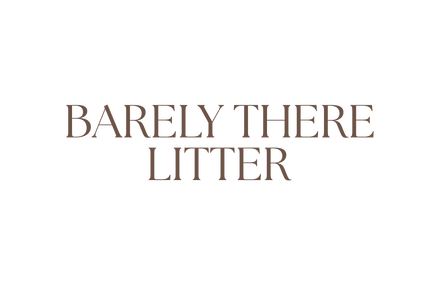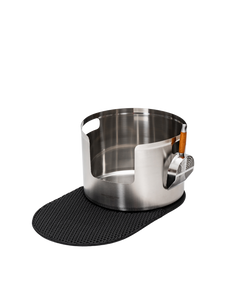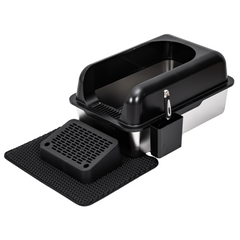Choosing the right cat litter is crucial for both the comfort of your feline friend and the cleanliness of your home. The cat litter market offers a variety of options, each with its own set of benefits and drawbacks. This comprehensive guide will explore the different types of cat litter available in Australia, focusing on their pros and cons, cost-effectiveness, eco-friendliness, and ability to control odours.
1. Clumping Clay Litter
Overview: Clumping clay litter is one of the most popular types of cat litter, appreciated for its ease of use and effective odour control.
-
Pros:
- High Absorbency: Quickly absorbs liquids and forms clumps, making it easy to scoop out urine and faeces.
- Effective Odour Control: Often contains additives like baking soda or charcoal to neutralise odours.
- Affordability: Generally more affordable than many other types of litter, making it a cost-effective option.
-
Cons:
- Dust and Tracking: Can create dust that may affect those with respiratory issues; can also be tracked around the house by your cat.
- Environmental Concerns: Made from bentonite clay, which is obtained through strip mining, impacting the environment.
- Weight: Heavier than other types, which can make handling and disposal more challenging.
-
Eco-Friendliness: Low, due to non-biodegradable nature and the environmental impact of clay mining.
-
Odour Elimination Effectiveness: High, especially in versions with added odor-control agents.
2. Non-Clumping Clay Litter
Overview: Non-clumping clay litter is an older style of cat litter and is often made from materials like attapulgite.
-
Pros:
- Cost-Effective: Usually cheaper than clumping clay litter.
- Good for Multiple Cats: Effective for households with more than one cat.
-
Cons:
- Less Efficient Odour Control: Without clumping action, waste can be harder to remove completely, leading to lingering odours.
- Frequent Changes Required: Needs to be changed more often than clumping litter.
- Dust Issues: Similar to clumping clay, it can produce dust.
-
Eco-Friendliness: Similar to clumping clay, it has low eco-friendliness due to its non-biodegradable nature and the environmental impact of mining.
-
Odour Elimination Effectiveness: Moderate; less effective than clumping clay but can be improved with regular maintenance.
3. Silica Gel Litter
Overview: Silica gel litter, made from silica dioxide sand, oxygen, and water, is a more modern solution.
-
Pros:
- Highly Absorbent: Excellent moisture absorption and odour control.
- Lightweight: Easier to handle and change compared to clay litters.
- Low Maintenance: Requires less frequent changing than clay litters.
-
Cons:
- Cost: More expensive than most clay litters.
- Potential Health Risks: If ingested in large amounts, it can be harmful to cats.
- Less Eco-Friendly: Not biodegradable, though it lasts longer than clay litter, reducing overall waste.
-
Eco-Friendliness: Moderate; though non-biodegradable, its longevity and reduced frequency of change can compensate slightly.
-
Odour Elimination Effectiveness: High; its high absorbency helps in controlling odours effectively.
4. Biodegradable Litters
Overview: Biodegradable litters are made from a variety of plant-based materials, offering an eco-friendly alternative to traditional clay litters.
-
Pros:
- Environmentally Friendly: Made from renewable resources and are fully biodegradable.
- Lightweight and Dust-Free: Easier to handle and less dusty compared to clay litters.
- Safe for Cats and Humans: Generally made from non-toxic, natural materials.
-
Cons:
- Cost: Often more expensive than clay litters.
- Variable Odour Control: The effectiveness in controlling odors can vary depending on the material and brand.
- Less Clumping: Some biodegradable litters may not clump as well as clay litters.
-
Eco-Friendliness: High, due to their biodegradable and compostable nature.
-
Odour Elimination Effectiveness: Can vary; some materials like pine or recycled paper are quite effective, while others may be less so.
5. Paper Litter
Overview: Paper litter is made from recycled paper and is an eco-friendly, lightweight option.
-
Pros:
- Eco-Friendly: Made from recycled materials and is completely biodegradable.
- Soft and Gentle: Good for cats with sensitive paws or post-surgical needs.
- Low Tracking and Dust-Free: Reduces mess around the house and is good for respiratory health.
-
Cons:
- Absorbency: Less absorbent than clay or silica gel litters.
- Odour Control: Not as effective in controlling odours without frequent changes.
-
Eco-Friendliness: Very high, given its recycled and biodegradable nature.
-
Odour Elimination Effectiveness: Moderate; requires more frequent changing to control odours effectively.
6. Wood and Pine Litter
Overview: Made from sawdust or pine, these litters offer a natural and biodegradable option.
-
Pros:
- Natural Odour Control: Wood and pine naturally neutralise odours without chemicals.
- Biodegradable and Compostable: An eco-friendly choice that can be composted after use.
- Low Dust: Good for cats and owners with respiratory sensitivities.
-
Cons:
- Non-Clumping: Most wood and pine litters do not clump, making clean-up different from traditional litters.
- Potential Allergies: Some cats or humans may be allergic to pine or wood products.
-
Eco-Friendliness: High, especially if sourced from sustainable forests.
-
Odour Elimination Effectiveness: Generally good, especially with fresh pine litter.
7. Crystal Cat Litter
Overview: Crystal cat litter, often made from silica gel, is known for its superior absorbency and odour control.
-
Pros:
- High Absorbency: Effectively absorbs urine and controls moisture.
- Low Maintenance: Requires less frequent changes than traditional clay litter.
- Minimal Tracking and Dust: Reduces the spread of litter outside the box.
-
Cons:
- Cost: Tends to be more expensive than clay and biodegradable litters.
- Non-Clumping: Does not form clumps, which can make spot cleaning more challenging.
- Environmental Concerns: Not biodegradable, raising environmental concerns.
-
Eco-Friendliness: Moderate; while it lasts longer, reducing the frequency of litter change, it is not biodegradable.
-
Odour Elimination Effectiveness: High, thanks to its excellent moisture absorption.
8. Walnut Shell Cat Litter
Overview: Made from ground walnut shells, this type of litter is a natural and biodegradable option.
-
Pros:
- Eco-Friendly: Biodegradable and made from a renewable resource.
- Clumping Ability: Good clumping properties make it easy to scoop and clean.
- Odour Control: Natural odour control without the addition of chemicals.
-
Cons:
- Allergen Concerns: May not be suitable for people or cats with nut allergies.
- Price: Can be more expensive than traditional clay litters.
-
Eco-Friendliness: High, due to its biodegradable nature and sustainable sourcing.
-
Odour Elimination Effectiveness: Good, with natural properties helping to neutralise odours.
9. Corn-Based Cat Litter
Overview: This litter is made from processed and dried corn, offering a natural, clumping, and eco-friendly alternative.
-
Pros:
- Biodegradable: An environmentally friendly option that can be composted.
- Effective Odour Control: Natural scent and absorbency help control odors.
- Lightweight and Clumping: Easier to handle and clean compared to clay litters.
-
Cons:
- Potential for Mould: If not changed regularly, it can develop mold.
- Cost: Typically more expensive than clay litters.
-
Eco-Friendliness: High, thanks to its natural, biodegradable composition.
-
Odour Elimination Effectiveness: Generally effective, especially in fresher batches.
10. Wheat-Based Cat Litter
Overview: Made from ground wheat, this litter offers natural clumping and odor control.
-
Pros:
- Clumping and Easy to Scoop: Forms clumps for easy removal of waste.
- Eco-Friendly: Biodegradable and made from renewable resources.
- Natural Odour Control: Wheat naturally neutralises odours.
-
Cons:
- Can Attract Bugs: Being a food-based product, it can attract insects if not stored properly.
- May Form a Paste: Can become sticky when wet.
-
Eco-Friendliness: High, due to its natural and biodegradable nature.
-
Odour Elimination Effectiveness: Good, with natural wheat enzymes neutralising odours.
11. Grass Seed Litter
Overview: A newer entrant in the cat litter market, grass seed litter is made from 100% natural grass seeds.
-
Pros:
- Lightweight and Soft: Easy on your cat's paws and easy to handle.
- Biodegradable: An eco-friendly choice that decomposes naturally.
- Effective Clumping: Facilitates easy clean-up and good odor control.
-
Cons:
- Cost: Can be more expensive than traditional clay litters.
- Availability: Might not be as readily available as other types of litter.
-
Eco-Friendliness: High, thanks to its fully biodegradable nature.
-
Odour Elimination Effectiveness: Good, due to its natural clumping and absorbency.
12. Bamboo Litter
Overview: Bamboo litter is a sustainable and eco-friendly option made from bamboo.
-
Pros:
- Sustainable: Bamboo is a fast-growing, renewable resource.
- Odour Control: Naturally controls odours without chemicals.
- Biodegradable: Decomposes quickly, reducing landfill waste.
-
Cons:
- Price: Generally more expensive than clay litters.
- Absorbency: May not be as absorbent as clay or silica litters.
-
Eco-Friendliness: Very high, due to its renewable source and biodegradability.
-
Odour Elimination Effectiveness: Moderate; effective in controlling odors but may require more frequent changes.
Conclusion and Buying Guide
In summarising the wide array of cat litters available, it’s evident that each type offers unique advantages and challenges. Your choice will largely depend on a combination of factors including:
- Eco-Friendliness: If environmental impact is a concern, biodegradable options like wood, corn, wheat, grass seed, or bamboo litters are ideal.
- Odour Control: For homes where odour control is a priority, silica gel, clumping clay, and some biodegradable litters are effective.
- Budget: While some eco-friendly options can be more expensive, they might offer long-term savings due to their longevity and efficiency.
- Cat Preference: Ultimately, your cat’s preference is crucial. Some cats may prefer certain textures or types over others.
When selecting cat litter, consider starting with small quantities to test your cat's acceptance. Remember, the transition to a new type of litter should be gradual to avoid any litter box aversion.
The cat litter market in Australia offers a diverse range of options catering to different needs and preferences. From traditional clumping clay to innovative eco-friendly alternatives, there is a litter to suit every cat and household. By considering factors such as eco-friendliness, odor control, cost, and most importantly, your cat's preference, you can select the best litter to ensure a clean, comfortable, and happy environment for your feline friend.







